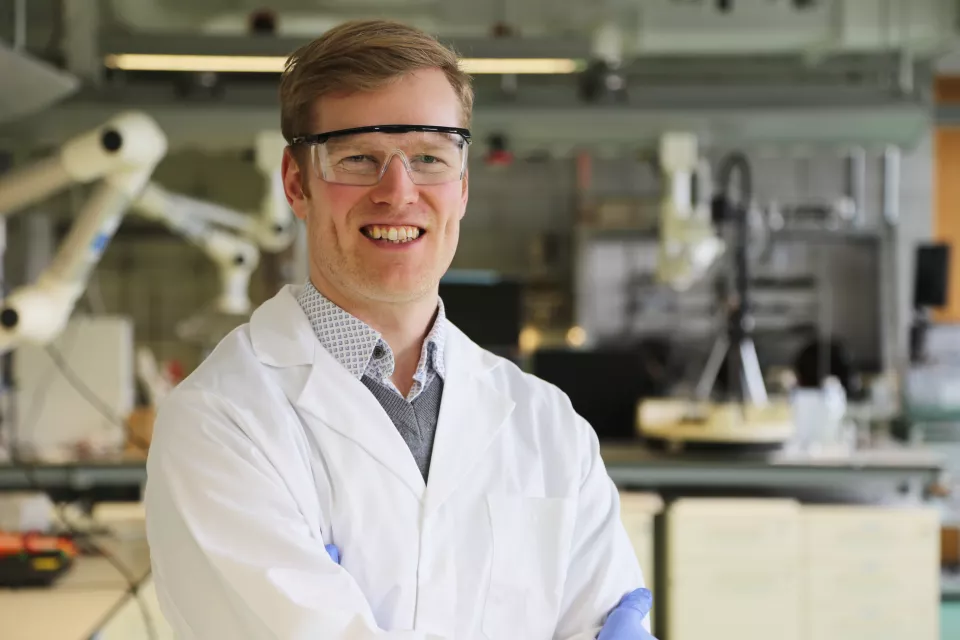
Research in Urology led Dr Eoghan Cunnane to segue into investigating the causes of male infertility, something which is becoming increasingly prevalent in the western world.
A lecturer of Biomedical Engineering and Principal Investigator at the Bernal Institute, a research centre in the Faculty of Science and Engineering, Eoghan is a recent recipient of the European Research Council Starting Grant. This funding means he has the resources to lead his own team of researchers as they examine this topical issue which some in the scientific community define as a crisis.
“Sperm concentration has dropped somewhere in the region of 50% since records began in the 1970s, and the pace of decline has actually increased since the year 2000,” Eoghan explains. “Traditional dogma will tell you that couples’ infertility is solely the responsibility of the female, but responsibility is actually closer to 50/50 between men and women. This research will examine the differences at a cell and tissue level between men who can and men who cannot produce sperm.”
Part of Eoghan’s research will involve evaluating existing treatments for infertility in men with nonobstructive azoospermia i.e. men whose testicles do not produce sperm.
“The treatments that are currently available for this are empirical, meaning that there is no mechanistic understanding or scientific basis for the choice.”
Eoghan’s work initially focused on urological research—working with the urethra (the tube that carries urine from your bladder outside the body) and examining its interactions with the anchoring balloon of a urinary Foley catheter, which is inflated in the bladder to keep the catheter in place while it drains urine.
“The balloon inflates in the bladder so you can't accidentally remove it, but it's a blind procedure and what can happen in some cases is the balloon is accidentally inflated in the urethra and this can lead to all sorts of complications. We wanted to characterise the tissue to understand how we could develop safety mechanisms to avoid this from happening. We worked with pig tissue in order to determine what was the pressure threshold within the system that would allow us to prevent damage. We found out that 150 kilopascals was the limit above which damage started to occur and we were able to develop a device based on this value.”
Once the experiment had been verified on animal tissue, it had to be tested on human tissue and this tissue was sourced from gender reassignment surgeries. Once it had passed this test it was trialled on patients.
“When I was working on this project, I was aware that our collaborator not only removed the urethra during gender reassignment surgery, but they also removed the testicles as well. This was an opportunity to work with whole human testicles and motivated me to move into the field of fertility.”
With his latest project, Eoghan and his team will characterise the properties of testicular tissue and then try to accurately represent the tissue in a state of health and disease, outside the body. In order to do this, they will create a pre-clinical model which will induce the human tissue and cells to become as close as they can to their ‘in vivo’ state or how they would behave in the body.
“We want to build a preclinical model that's informed by the characterisation of the human testes, one that is representative, but that is also amenable to high throughput testing and automated analysis. By creating a model that is high throughput, your statistical power is much higher, and you can have more confidence in what you are observing. A lot of people have previously tried and are currently trying to build a preclinical model of the testes and it's a very challenging thing to do because you are taking germ cells the whole way through their development to the final sperm cell, which is capable of penetrating an egg and forming new life.”
Eoghan’s parents were role models for his career choice, and the environment in the Faculty of Science and Engineering at the University of Limerick was supportive of students interested in research.
“My father has a PhD and lectured in electrochemistry for many years. My mother has a research masters and works in the UL Library. Research is something that would have been highly valued in my home, but the catalyst to pursue a career in research was when I was finishing my third year in biomedical engineering and I received a summer bursary to work in Professor Michael Walsh's lab. The skills that I'd been developing for the three previous years were applied to investigate something that had never been looked at before and that was very exciting.”
This sense of enthusiasm has stayed with Eoghan who can now look forward to working with his own research team with the opportunity that the ERC Starting Grant has afforded.
“I am fortunate to have been able to form the team that is in place now, working with really qualified and inspiring people on a project that I am interested in. Seeing them leveraging all of their existing skills and interests and develop as researchers has been a really rewarding part of this journey.”
